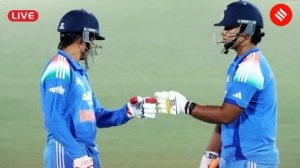Welcome to the Matrix
At the nets, Sreesanth and Gautam Gambhir keep fighting over that imaginary fielder standing at point.

At the nets, Sreesanth and Gautam Gambhir keep fighting over that imaginary fielder standing at point. At the adjacent practice wicket, Ishant Sharma and Virender Sehwag debate over the man standing at short mid-wicket.
To outsiders, it might seem light-hearted banter to find the Indians arguing over a ‘fielder’ who is not existing. But this is serious business—and the secret behind their success right through the Australia series—they have indulged in for achieving the flattering economical figures and strike-rates.
It’s a simulated match-reality advised by bowling coach Venkatesh Prasad to subdue the Australians. Sreesanth runs in to bowl at Gambhir but in his mind, it’s Matthew Hayden batting. Ishant bowls at Andrew Symonds in the mind but it’s Sehwag who is facing him. The Indian bowlers have memorised the shots the Australians play, their areas of strength and weakness, their specific areas of slog—all designed by computer programmer Dhananjaya and operated by the ‘pace-spin’ battery.
Advanced simulation
In a chat with The Indian Express, Prasad explains the ‘Matrix’ theory. “It’s basically an advanced stage of match simulation. On long tours, it’s important to keep up the intensity and bowlers often get bored of bowling in the nets. So, we keep innovating, where one day we ask them to defend runs, on another day we tell them to get the batsmen out by bowling to a set field. So, when Yuvraj Singh bats, they think it’s Mike Hussey,” he says.
Prasad believes this Indian bowling lot is very different, and is cut out for success Down Under. “One main reason for its success is all the bowlers have their own stock balls and they can keep bowling it as many times with same precision. Also, the Indians generally don’t hit the deck unlike the Australians. So, the trajectory of the ball is different and allows lesser time for the batsman. We bowl quick and get the ball to swing as well because this entire lot releases the ball with a beautiful seam position,” he says.
Ishant believes that “the kookaburra used in matches is hand-stitched and has a slightly pronounced seam than the normal machine-sewn ones, allowing them to exploit deviation off the seam as well.” However, it’s not all work and no play for these fast-bowlers. They do get their weekly offs, where they can just stand and see other going through the grind, and can let themselves free in the nets without bothering about anything.
That’s the time when the back-of-the hand deliveries come rolling, the yorkers are tested and slow-cutters are experimented.
Big-hitters’ club
They get their batting stints, too, in the nets to get back with a vengeance by all those lusty hits.
Harbhajan Singh is one who loves to hit it big in the nets. The off-spinner has been a master in containing the batsmen but wickets haven’t fallen to his expectations. His economy rate of 4.31 is the second-best in the lot — two-match old Praveen Kumar tops the chart — but with five wickets from eight matches, Harbhajan’s success hasn’t matched his consistent bowling.
There’s a temptation to imagine that spinners have been left behind with all the medium-pacer talk with Prasad around. But he’s quick to dismiss it. “Of course, the spinners have a big role and I also keep working with them. I spend a lot of time talking to Piyush Chawla but with the seniors you don’t need to because they know how to correct their flaws. I interact with the bowlers a lot. I like Irfan Pathan because he keeps asking questions all the time. It shows that he’s working a lot and thinking all the time on his bowling,” says Prasad.
India’s bowling has outdone their batting repeatedly and has often set up victories on this tour. As the tour nears its fag end, the Indian bowlers are still bubbling with energy, and are eyeing the Cup that will cheer their excellent show Down Under so far.



- 01
- 02
- 03
- 04
- 05




























